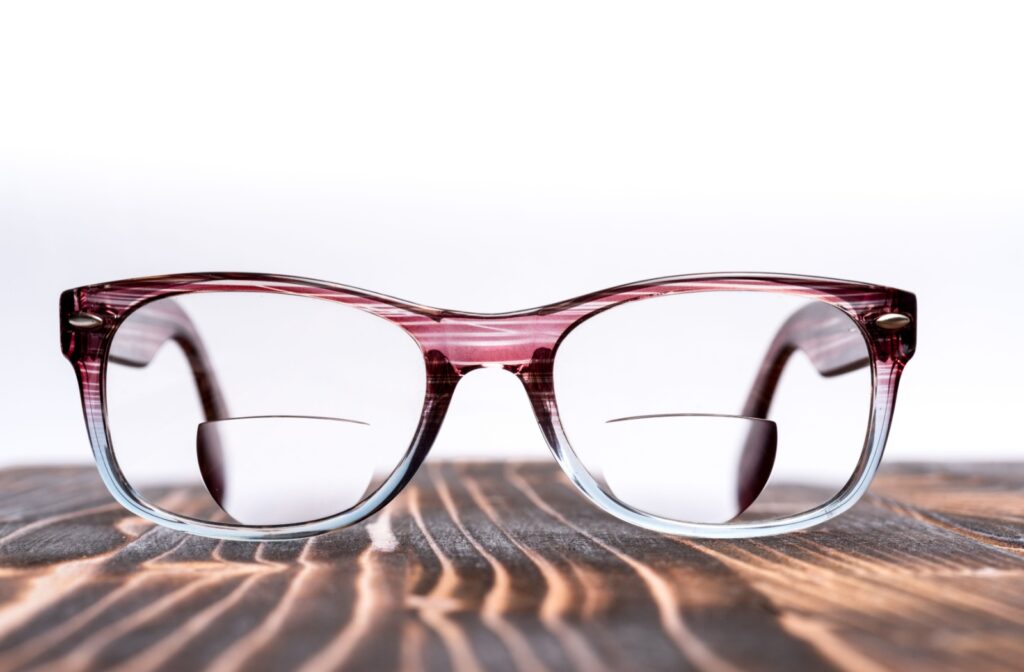Bifocal glasses are a popular and practical solution for people who need help seeing both near and far. Bifocals typically feature a segment in the lower half of the lens designed for near tasks like reading, while the upper part of the lenses correct distance vision.
This dual-focus design supports everyday activities without needing multiple pairs of glasses. Whether you’re managing presbyopia, frequently switching focus throughout the day, or seeking options for myopia control, bifocal glasses offer reliable, efficient vision correction tailored to your lifestyle needs.
Understanding Bifocal Glasses
Bifocal glasses are a type of multifocal eyewear designed to correct more than one vision issue with a single pair of lenses. Each lens contains two distinct optical powers: the upper portion is typically used for distance vision, while the lower portion supports close-up tasks like reading or using a phone.
This dual-focus design is particularly helpful for people with presbyopia, a common age-related condition that makes it difficult to see nearby objects clearly, as well as nearsightedness. It’s also useful for those who deal with both near and distance vision problems, allowing them to perform everyday activities without needing to switch between multiple pairs of glasses.
How Do Bifocal Lenses Work?
Each segment of a bifocal lens has a specific purpose. The top segment corrects distance vision, addressing refractive errors like myopia (nearsightedness) or hyperopia (farsightedness). The bottom portion is intended for near vision tasks, such as reading or sewing. This layout reflects how we typically use our eyes, looking straight ahead or slightly upward for distance, and slightly downward for up-close tasks.
The boundary between the two segments is often visible, marked by a distinct line or curve, though newer designs may minimize this visual disruption.
Bifocals vs. Single-Vision & Progressive Lenses
Bifocal glasses differ significantly from single-vision lenses, which have one uniform prescription throughout the lens. Single-vision glasses are typically used to correct either near or far vision, but not both.
Progressive lenses, another type of multifocal eyewear, offer a smooth and gradual transition between three viewing zones: near, intermediate, and distance. They don’t have a visible dividing line like bifocals and are often chosen for their cosmetic appeal and more natural visual experience.
Bifocals offer an immediate, straightforward transition between near and far vision, which some people find easier to adapt to.
Who Should Consider Bifocal Glasses?
Bifocal glasses are most commonly associated with aging adults experiencing presbyopia, which typically begins in your 40s. But they aren’t just for older adults. Several groups of people can benefit from wearing bifocals, including:
- Multitaskers who frequently alternate between reading and distance tasks, such as drivers, crafters, or teachers.
- Office workers or frequent screen users who experience digital eye strain but also need to maintain clear distance vision.
- Children with myopia, particularly those undergoing treatment plans to manage the progression of their nearsightedness.
Using Bifocals for Myopia Control in Children
Bifocal glasses are also part of a growing toolkit used in pediatric eye care for managing myopia progression.
Myopia progression in children can lead to high myopia, which increases the risk of vision-threatening conditions later in life, such as:
- Glaucoma
- Cataracts
- Retinal tears or detachments
- Myopic macular degeneration
By incorporating different focal lengths, bifocal lenses reduce the amount of near-work strain placed on the eyes. Bifocals are often prescribed alongside or in place of other myopia control treatments, such as:
- Low-dose atropine drops
- Orthokeratology (Ortho-K)
- MiSight contact lenses
- Defocus Multiple Segment (DIMS) lenses
Research shows that children between 8 and 13 respond well to bifocal therapy.

Getting Used to Bifocal Glasses
While the benefits of bifocals are many, it’s normal for new bifocal wearers to need an adjustment period. Symptoms like headaches, mild dizziness, or visual distortion can occur during the first few days.
Here are a few tips to help you adapt quicker:
- Wear your bifocals consistently to help your brain and eyes adjust to the lens segments.
- Start in familiar environments, where visual cues are predictable.
- Practice looking through the different zones while walking, sitting, or reading to build muscle memory.
- Make sure that your lenses are aligned correctly, so that the bifocal lens segments are in the correct position relative to your line of sight.
If issues persist, we can make any needed adjustments to your prescription or your frame.
Discover the Benefits of Bifocal Glasses
Bifocal glasses do more than correct your vision, they also simplify your day-to-day life. With one pair of lenses, you can handle close-up work and distance viewing without constant switching. From reading recipes to driving safely, bifocals help keep your vision clear and comfortable.
If you’re experiencing blurred vision at different distances or need a solution for myopia control, our team at Total Vision Richmond is here to help. Book an appointment today to explore whether bifocal glasses are the right fit for your needs. Let’s make your everyday vision clearer and more convenient.


